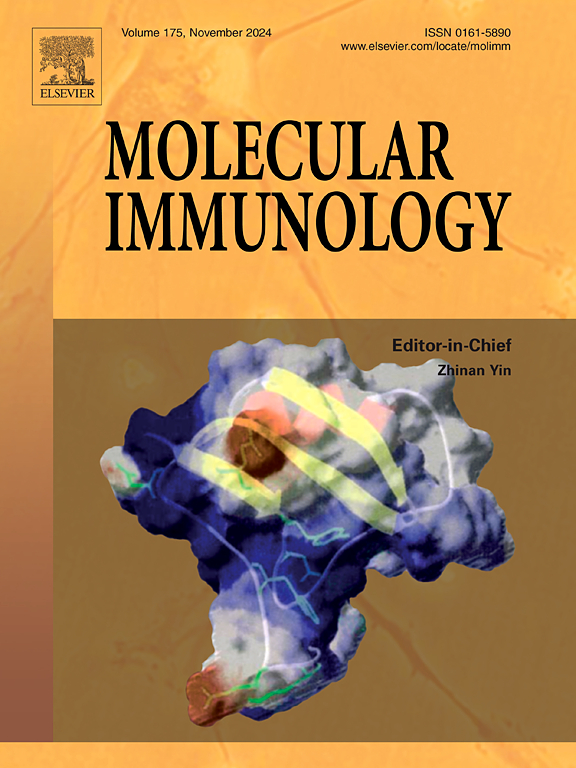The superantigen SEA binds to human γδ T cell receptor and activates γδ T cells with moderate MHC class II dependence
IF 3.2
3区 医学
Q2 BIOCHEMISTRY & MOLECULAR BIOLOGY
引用次数: 0
Abstract
Bacterial toxins, called superantigens, are produced by Staphylococcus aureus and are known to activate γδ T cells. γδ T cells contribute to long-lasting immunity against bacterial skin infections caused by S. aureus. γδ T cells are a distinct subgroup of T cells containing the T cell receptor (TCR) γ and δ chains. The γδ TCR harbouring the variable chains TRGV9/TRDV2 is the most common TCR in human peripheral blood and is known to be activated by superantigens and are also promising candidates for tumor immunotherapy. However, detailed analyses of antigen binding to γδ TCR have been severely hampered by difficulties in producing large amounts of γδ TCR. In this study, we report a protocol to produce recombinant γδ TCR (TRGV9/TRDV2) by fusing the variable domains γδ TCR with the constant domains of αβ TCR. Subsequently, binding analyses were executed applying microscale thermophoresis showing a clear binding between superantigen and the γδ TCR in the micro molar range. In addition, the superantigen SEA was shown to induce cytokine expression in γδ T cells with moderate MHC dependence, suggesting that other receptors can act as antigen presenting molecules upon γδ T cell activation. These results pave the way towards a better understanding of superantigen recognition by the γδ T cells and facilitates the future use of γδ TCR in cellular tumor immunotherapy.
超抗原SEA结合人γδ T细胞受体,激活γδ T细胞,具有中等程度的MHC II类依赖性
被称为超级抗原的细菌毒素是由金黄色葡萄球菌产生的,已知可以激活γδ T细胞。γδ T细胞有助于对金黄色葡萄球菌引起的细菌性皮肤感染的持久免疫。γδ T细胞是含有T细胞受体(TCR) γ和δ链的T细胞的一个独特亚群。含有可变链TRGV9/TRDV2的γδ TCR是人类外周血中最常见的TCR,已知可被超抗原激活,也是肿瘤免疫治疗的有希望的候选者。然而,由于大量生产γδ TCR的困难,对抗原与γδ TCR结合的详细分析受到严重阻碍。在本研究中,我们报道了一种将可变结构域γδ TCR与αβ TCR的恒定结构域融合产生重组γδ TCR (TRGV9/TRDV2)的方案。随后,应用微尺度热电泳进行结合分析,显示超抗原与γδ TCR在微摩尔范围内明显结合。此外,超抗原SEA可以诱导γδ T细胞中细胞因子的表达,并具有中等程度的MHC依赖性,这表明其他受体可以作为抗原提呈分子激活γδ T细胞。这些结果为更好地理解γδ T细胞对超抗原的识别铺平了道路,并促进了γδ TCR在细胞肿瘤免疫治疗中的未来应用。
本文章由计算机程序翻译,如有差异,请以英文原文为准。
求助全文
约1分钟内获得全文
求助全文
来源期刊

Molecular immunology
医学-免疫学
CiteScore
6.90
自引率
2.80%
发文量
324
审稿时长
50 days
期刊介绍:
Molecular Immunology publishes original articles, reviews and commentaries on all areas of immunology, with a particular focus on description of cellular, biochemical or genetic mechanisms underlying immunological phenomena. Studies on all model organisms, from invertebrates to humans, are suitable. Examples include, but are not restricted to:
Infection, autoimmunity, transplantation, immunodeficiencies, inflammation and tumor immunology
Mechanisms of induction, regulation and termination of innate and adaptive immunity
Intercellular communication, cooperation and regulation
Intracellular mechanisms of immunity (endocytosis, protein trafficking, pathogen recognition, antigen presentation, etc)
Mechanisms of action of the cells and molecules of the immune system
Structural analysis
Development of the immune system
Comparative immunology and evolution of the immune system
"Omics" studies and bioinformatics
Vaccines, biotechnology and therapeutic manipulation of the immune system (therapeutic antibodies, cytokines, cellular therapies, etc)
Technical developments.
 求助内容:
求助内容: 应助结果提醒方式:
应助结果提醒方式:


